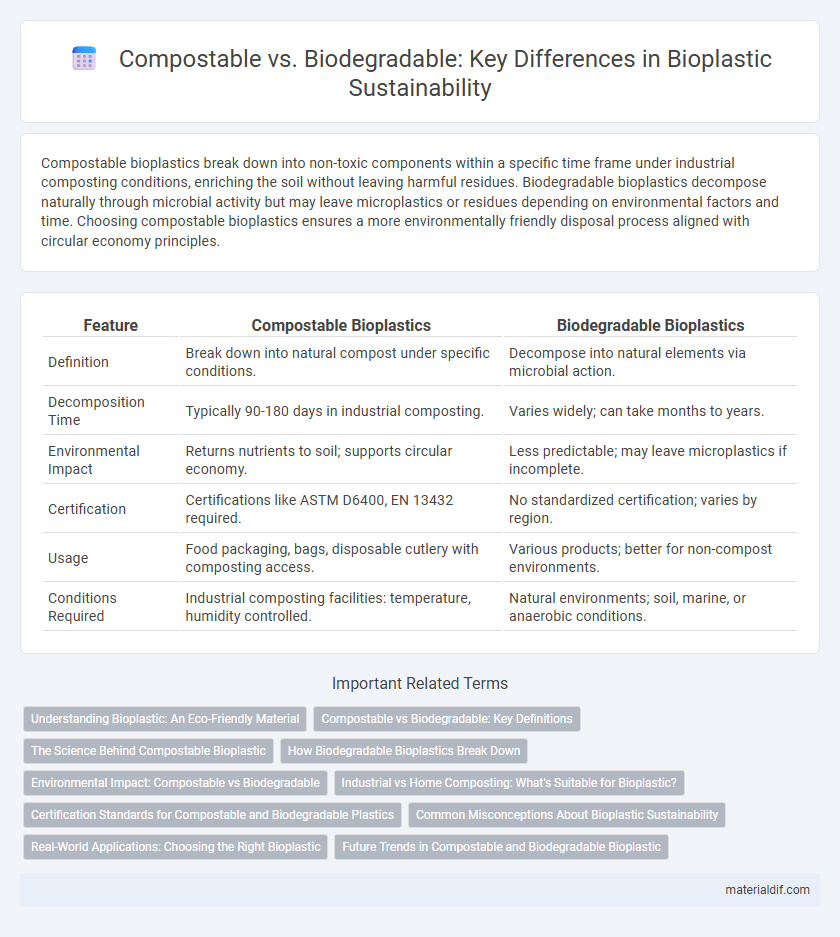Compostable bioplastics break down into non-toxic components within a specific time frame under industrial composting conditions, enriching the soil without leaving harmful residues. Biodegradable bioplastics decompose naturally through microbial activity but may leave microplastics or residues depending on environmental factors and time. Choosing compostable bioplastics ensures a more environmentally friendly disposal process aligned with circular economy principles.
Table of Comparison
| Feature | Compostable Bioplastics | Biodegradable Bioplastics |
|---|---|---|
| Definition | Break down into natural compost under specific conditions. | Decompose into natural elements via microbial action. |
| Decomposition Time | Typically 90-180 days in industrial composting. | Varies widely; can take months to years. |
| Environmental Impact | Returns nutrients to soil; supports circular economy. | Less predictable; may leave microplastics if incomplete. |
| Certification | Certifications like ASTM D6400, EN 13432 required. | No standardized certification; varies by region. |
| Usage | Food packaging, bags, disposable cutlery with composting access. | Various products; better for non-compost environments. |
| Conditions Required | Industrial composting facilities: temperature, humidity controlled. | Natural environments; soil, marine, or anaerobic conditions. |
Understanding Bioplastic: An Eco-Friendly Material
Compostable bioplastics break down into non-toxic components within a defined time under specific composting conditions, ensuring they enrich soil without leaving harmful residues. Biodegradable bioplastics, however, decompose naturally through microbial activity but may vary significantly in their breakdown time and environmental impact. Understanding these differences is crucial for selecting the right bioplastic that supports sustainable waste management and reduces pollution effectively.
Compostable vs Biodegradable: Key Definitions
Compostable bioplastics break down into nutrient-rich compost within a specific timeframe under industrial composting conditions, leaving no toxic residue. Biodegradable bioplastics decompose through natural microbial activity but lack a standardized timeline or environmental conditions, which can result in incomplete degradation. Understanding the distinction between compostable and biodegradable materials is essential for effective waste management and environmental sustainability.
The Science Behind Compostable Bioplastic
Compostable bioplastics undergo a defined biochemical process driven by microorganisms that break down polymer chains into carbon dioxide, water, and biomass under controlled industrial composting conditions. Unlike general biodegradable plastics, which may degrade slowly or leave microplastic residues, compostable bioplastics meet international standards such as ASTM D6400 or EN 13432, ensuring complete disintegration and non-toxicity within specific timeframes. This scientific distinction ensures that compostable bioplastics contribute significantly to reducing landfill waste and promoting sustainable organic recycling cycles.
How Biodegradable Bioplastics Break Down
Biodegradable bioplastics break down through natural processes involving microorganisms such as bacteria and fungi, which enzymatically decompose the material into water, carbon dioxide, and biomass. This degradation occurs under specific environmental conditions including temperature, humidity, and presence of oxygen, often within industrial composting facilities. Unlike compostable plastics that require controlled settings, biodegradable bioplastics can degrade in varied environments, though the rate and extent of breakdown depend heavily on the bioplastic's chemical composition and surrounding ecosystem.
Environmental Impact: Compostable vs Biodegradable
Compostable plastics break down into nutrient-rich organic matter within a specific timeframe under industrial composting conditions, minimizing landfill waste and reducing greenhouse gas emissions. Biodegradable plastics decompose through microbial activity but may leave behind microplastics if not fully broken down, potentially harming soil and aquatic ecosystems. The environmental impact of compostable plastics is generally lower due to their complete mineralization, supporting circular waste management and soil health restoration.
Industrial vs Home Composting: What's Suitable for Bioplastic?
Compostable bioplastics require specific conditions provided by industrial composting facilities, including high temperatures above 55degC and controlled humidity, to break down efficiently within a defined timeframe. Home composting lacks these regulated conditions, often resulting in incomplete degradation or prolonged decomposition periods for bioplastics labeled as industrially compostable. Selecting the appropriate bioplastic depends on its certification for either industrial composting standards such as EN 13432 or ASTM D6400, or its capability to degrade in less controlled home compost environments.
Certification Standards for Compostable and Biodegradable Plastics
Certification standards for compostable plastics, such as ASTM D6400 and EN 13432, ensure these materials break down into non-toxic components within industrial composting facilities in a specified timeframe. Biodegradable plastics are evaluated under standards like ASTM D5338 and ISO 14855, emphasizing microbial decomposition under controlled conditions but without necessarily requiring complete disintegration like compostables. Compliance with these certifications guarantees verified environmental performance, supporting waste management practices and reducing plastic pollution effectively.
Common Misconceptions About Bioplastic Sustainability
Compostable bioplastics break down into natural elements within a specific timeframe under industrial composting conditions, whereas biodegradable bioplastics degrade into simpler compounds over time but without guaranteed environmental benefits. Many consumers mistakenly believe all bioplastics are compostable or environmentally harmless, overlooking the need for proper disposal methods and specific waste management infrastructure. Misconceptions about bioplastic sustainability can lead to increased contamination in recycling streams and diminished environmental performance.
Real-World Applications: Choosing the Right Bioplastic
Compostable bioplastics break down into nutrient-rich compost within a controlled industrial environment, making them ideal for agricultural mulch films and food packaging designed for organic waste streams. Biodegradable bioplastics degrade naturally over time but often require specific environmental conditions, suitable for products like disposable cutlery and shopping bags where rapid decomposition is not critical. Selecting the right bioplastic relies on understanding waste management infrastructure and product lifecycle to optimize environmental benefits and reduce landfill impact.
Future Trends in Compostable and Biodegradable Bioplastic
Future trends in compostable and biodegradable bioplastics emphasize increased integration of advanced enzymatic additives that accelerate decomposition in various environments, including industrial and home composting systems. Innovations in feedstock sources, such as algae and agricultural residues, aim to enhance sustainability while reducing reliance on food crops. Regulatory frameworks are evolving to standardize certification processes, promoting transparency and consumer trust in labeling and waste management practices.
Compostable vs Biodegradable Infographic

 materialdif.com
materialdif.com